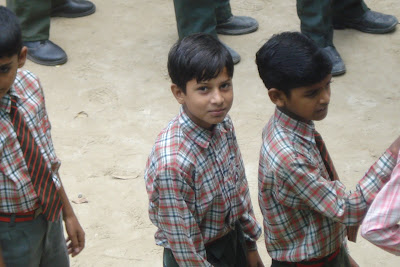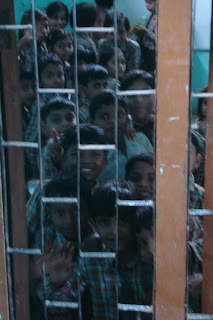 I went to another school in a town called Bhagwanpur. This is a very overcrowded school now and it has a short but impressive history. It started as just a three room school not too far from its current location with just twenty three students. Two rooms were classrooms and one was an office for the teachers. After just three years the school became packed with just over 60 students crammed into their two small rooms. With an increasing demand to take more students they needed to find a new facility.
I went to another school in a town called Bhagwanpur. This is a very overcrowded school now and it has a short but impressive history. It started as just a three room school not too far from its current location with just twenty three students. Two rooms were classrooms and one was an office for the teachers. After just three years the school became packed with just over 60 students crammed into their two small rooms. With an increasing demand to take more students they needed to find a new facility.Their current building became available to rent and so they took the opportunity to move into the
 new location which had ten or twelve rooms that could be used as class rooms as well as a few offices. The school currently is running around 500 students form K through 8th grade. Their current class size is about forty to fifty students per class.
new location which had ten or twelve rooms that could be used as class rooms as well as a few offices. The school currently is running around 500 students form K through 8th grade. Their current class size is about forty to fifty students per class. The Indian people value education so much so that if there is a chance their student can attend classes in a non-government school they do anything they can to get their kids in. It just so happens that the schools that are run by Christian organizations have the best reputation
 for education so they are the most sought after schools. This one is so full that they are in need of moving again and they have only been in existence for six years.
for education so they are the most sought after schools. This one is so full that they are in need of moving again and they have only been in existence for six years.They have purchased a plot of land that is about two acres in total. The plan is to build something similar to what was built in Pathrie. A large three story complex with classrooms and some offices. And then build some housing for teachers and administrators as well.
One thing that set this school apart from Pathrie however is that this school also has an orphanage as part of the ministry to the community. They only have room for 30 kids. They actually call it a children's home. Each group of six to ten kids has an adult couple that cares for them. The idea is that each couple acts like parents to these kids and each kid is like a sibling to the other in their "family". They try to create some semblance of a family for these little ones.

I walked into one of the rooms while the kids were in class as part of a tour I was getting of the facilities and started crying. (No one else was around me). I don't know who the kids are who slept in that room, I don't know their stories, I could not point them out in a crowd, or if they were standing in front of me, but I cried for them. No child should ever be thrown away. What does it do to a child and later on as an adult to know that some one cared just enough to not abort them but not enough to care for them personally. I know that this is not the case for many of the students but it for some. I have
 personally heard enough stories to imagine what some of the stories in this room might be like.
personally heard enough stories to imagine what some of the stories in this room might be like.This is the land that was purchased for the new facility. It is a field today, but hopefully in another year or two they will have the money to build at least the first floor of their dream.
I walked out of the building not wanting to leave. I really wanted to see the kids when they got out of school and give them a hug, and tell them that even if no one else loved them, that Jesus loved them. But I the reality is that two minutes with me is not going to change things for them. It might make me feel better, but it does nothing for them. The heroes here are the couples who have dedicated themselves to bringing up kids who are not theirs to understand the love of God.
 This is one of the bedrooms at the Children's home. It is right next to the school. You notice their beds are neatly made and on one of the beds, (it is hard to tell) there is a Bible sitting there. These kids have very few if any personal possessions. To have your own book is a big deal especially if it is a Bible.
This is one of the bedrooms at the Children's home. It is right next to the school. You notice their beds are neatly made and on one of the beds, (it is hard to tell) there is a Bible sitting there. These kids have very few if any personal possessions. To have your own book is a big deal especially if it is a Bible.No one else in their society is concerned about showing them this kind of love. Not even their own family members. At least the Muslims will care for extended family when they are in need; even the Sikhs, a Hindu reform group which started about 600 years ago will care for extended family who have fallen on hard times. But if you are a Hindu and you fall on hard times it is because you deserve it. And children sometimes pay a high price for this. I am so thankful for the people in these schools and homes who are dedicated to the next generation of Indians.














































